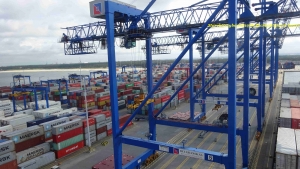Decarbonization on ships. Costs in ports and cargo carriers

By Marek Grzybowski
The International Maritime Organization’s policy on monitoring ship energy efficiency, launched in January, already affects both the speed at which container ships sail and the type of propulsion of ships ordered by operators, Drewry experts note based on the latest market information.
In their opinion, maritime transport is finally changing in its approach to environmental protection. New guidelines on decarbonization and sustainable development are being introduced decisively by shipowners and ports. As a result, cargo managers and forwarders are also starting to introduce real changes in the processes of organizing transport chains.
Many ports already offer systems for powering from shore or bunkering with alternative fuels. There is progress. However, there are exceptions. Not all shipowners and not all ports have joined the process of decarbonization of shipping.
“Show me the money”
“Show me the money”, exhorts Peter Jonathan Jameson, managing director and partner at Boston Consulting Group (BCG), and emphasizes that it is necessary to “redefine commercial models in shipping. “There is an imperative that will encourage the decarbonization of fleets and unlocking [the fleet reconstruction process – Ministry of Economy] on a mass scale.”
Intensive preparations are underway to operate in the new conditions related to the costs of sea transport. In less than 4 months, fees for carbon dioxide emissions in maritime transport will come into force. The largest operators have already worked out the charging rules. But many operators and forwarders may be surprised. Drewry experts declare their help.
Inspection companies will have at their disposal devices whose results cannot be questioned. “Advanced equipment can accurately measure the amount of CO2, or harmful particles, emitted by ships. The technology is already available, says Morten Brandborg, CEO of Green Instruments. It is simply a matter of whether shipping companies make relatively modest investments in this equipment to demonstrate compliance with specific emission limits.
Shipowners will treat such an investment as a cost, of course. Then shipping companies that do not voluntarily install such a device on cargo ships, cruise ships, ferries and other types of ships should show actual documented emissions, not calculated ones, suggests Brandborg.
In his opinion, “replacing uncertain calculations with hard data will significantly increase the operator’s credibility and will be beneficial for the climate.”
ETS means costs
There are currently two EU carbon pricing systems in place, which shipping will soon be subject to. Carbon dioxide (CO2) emissions from ships ≥5000GT in 2024 reported under the EU Monitoring, Reporting and Verification (MRV) system will also be included in the regional Emissions Trading Scheme (ETS).
ETS ships will need to purchase EU allowances (EUA) to cover half of their greenhouse gas (GHG) emissions to and from EU, Norway and Iceland (EEA) ports, as well as all emissions on intra-EEA voyages and while at berth in ports EEA.
In 2025, 40% of CO2 emissions from cruises and berth stops will be subject to the ETS in 2024, rising to 100% in 2027. With the end of the phasing-in of the ETS, shipowners are suffering a double financial blow. In 2026, the MRW Regulation will also require reporting of CH4 (methane) and N2O (nitrous oxide) emissions from ships, with EUA fees to be paid under the ETS on 100% of the CO2 equivalent of these emissions, in addition to CO2, by 2027.
FuelEU Maritime
The second mechanism is FuelEU Maritime, which will enter into force in 2025. The regulation sets targets for reducing the average annual greenhouse gas emission intensity resulting from the energy consumed by a ship (or, most importantly, a fleet or group of ships).
The required GHG emission intensity reduction starts from a low level of -2% in 2025 (compared to the 2020 baseline), reaching -6% in 2030 and -14.5% in 2035, until to -80% by 2050. The penalty or reward is then calculated based on the degree of under- or over-performance against the vessel or fleet’s target for the year and the cost of low-carbon fuel that would be needed to achieve that target.
5 actions forward Drewry
“Drewry is closely monitoring the market and has developed the first set of sustainability best practices that shippers and BCOs (beneficial cargo owners) can implement within their existing procurement processes. Our solutions range from cost calculation tools to practical workshops with customer teams on “how to be a sustainable freight forwarder.”
Drewry’s team of consultants has already implemented sustainable development programs in maritime transport and provides the first suggestions in the latest announcement.
Firstly, the operator should take into account CO2 emissions and potential costs under the ETS when submitting offers. Some BCOs are already asking bidders to specify the CO2 emissions of the maritime transport services they offer in their offers.
“The change is now that some forwarders actually make decisions based on information about the CO2 emissions of the means of transport,” note Drewry experts, reporting that they have already developed best practices in cargo allocation.
In the fight to cut costs, some freight forwarders are now resisting carriers’ requests to charge separate ETS (Emissions Trading System) fees on routes to and from Europe and on short sea traffic between European ports.
The European Commission, in its report of March 13, 2023, points out that “At EU level, maritime transport is responsible for 3-4% of total CO2 emissions in the EU, which means over 124 million tonnes of CO2 in 2021.”
Other shippers ask carriers to separate them as part of their offer, and Drewry recommends doing so. The next action is to transfer the fees for the emission of harmful substances by the ship to the cargo owner or forwarder. The European Commission reported in a report on maritime transport that “In 2018, global emissions from shipping amounted to 1,076 million tonnes of CO2 and accounted for approximately 2.9% of global emissions caused by human activities.”
EUR 170 to EUR 500 per container extra?
In 2022, Maersk estimated that, based on various assumptions, the ETS cost would be €170 ($186) per 40-foot container shipped from the Far East to Northern Europe. MSC also plans to pass on climate costs to customers. In 2022, he suggested that transporting a 40-foot reefer container would cost an extra $500 on services between Europe and the Far East, Shipping Watch reported in March 2022.
Interestingly, many customers of shipping operators were ready to pay additional costs passed on by ocean operators to customers, according to research by the Boston Consulting Group.
“Our survey last year showed that over 80% of customers are willing to pay a premium for zero-emission shipping. This finding not only highlights customer contributions to the solution, but also suggests the potential that exists to drive further value into the ecosystem. Moreover, approximately 60% of respondents anticipate an increase in their willingness to pay in the future, notes Peter Jonathan Jameson, Managing Director and Partner, Boston Consulting Group (BCG) with surprise.
Since then, major ocean carriers have been reticent and have not published new information about the ETS-related surcharges they intend to collect from January 2024.
Drewry responded to this silence in the shipping airwaves and launched a customized cost calculation tool called ‘Carbon Tax and New Fuel’. The calculations are available to shippers and allow them to estimate additional costs on major ocean services.
Fifth course of action
In the next steps, Drewry suggests starting to measure CO2 emissions, implementing a sustainable development program by operators and carefully reading contracts for the transport of goods by sea signed with the operator, forwarder or NVO.
Ports are already bearing the costs of decarbonization in shipping. They were forced to install systems for supplying ships with electricity from the quay and energy storage, as well as systems for bunkering LNG and alternative fuels, including methanol.
There is a fifth direction of action to reduce emissions of harmful substances in ocean shipping. “Automation is the key to cleaner and more sustainable maritime transport,” says Gurinder Singh, Director of Technical Sales at ABS Wavesight. And let’s follow this path in shipping and ports, and we will save fuel and money and spare the environment additional CO2 emissions.
